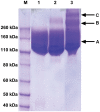Impact of large aggregated uricases and PEG diol on accelerated blood clearance of PEGylated canine uricase
- PMID: 22745806
- PMCID: PMC3383732
- DOI: 10.1371/journal.pone.0039659
Impact of large aggregated uricases and PEG diol on accelerated blood clearance of PEGylated canine uricase
Abstract
Background: Uricase has proven therapeutic value in treating hyperuricemia but sufficient reduction of its immunogenicity may be the largest obstacle to its chronic use. In this study, canine uricase was modified with 5 kDa mPEG-SPA and the impact of large aggregated uricases and cross-linked conjugates induced by difunctional PEG diol on immunogenicity was investigated.
Methods and findings: Recombinant canine uricase was first expressed and purified to homogeneity. Source 15Q anion-exchange chromatography was used to separate tetrameric and aggregated uricase prior to pegylation, while DEAE anion-exchange chromatography was used to remove Di-acid PEG (precursor of PEG diol) from unfractionated 5 kDa mPEG-propionic acid. Tetrameric and aggregated uricases were separately modified with the purified mPEG-SPA. In addition, tetrameric uricases was modified with unfractionated mPEG-SPA, resulting in three types of 5 kDa mPEG-SPA modified uricase. The conjugate size was evaluated by dynamic light scattering and transmission electron microscope. The influence of differently PEGylated uricases on pharmacokinetics and immunogenicity were evaluated in vivo. The accelerated blood clearance (ABC) phenomenon previously identified for PEGylated liposomes occurred in rats injected with PEGylated uricase aggregates. Anti-PEG IgM antibodies, rather than neutralizing antibodies, were found to mediate the ABC.
Conclusions: The size of conjugates is important for triggering such phenomena and we speculate that 40-60 nm is the lower size limit that can trigger ABC. Removal of the uricase aggregates and the PEG diol contaminant and modifying with small PEG reagents enabled ABC to be successfully avoided and sufficient reduction in the immunogenicity of 5 kDa mPEG-modified tetrameric canine uricase.
Conflict of interest statement
Figures









References
-
- Smyth CJ. Disorders associated with hyperuricemia. Arthritis Rheum. 1975;18:713–719. - PubMed
-
- Kissel P, Mauuary G, Royer R, Toussain P. Letter: Treatment of malignant haemopathies and urate oxidase. Lancet. 1975;1:229. - PubMed
-
- Sibony G, North ML, Bergerat JP, Lang JM, Oberling F. [Hyperuricemia resistant to urate oxidase. Role of anti-serum urate oxidase precipitating antibodies]. Presse Med. 1984;13:443. - PubMed
-
- Davis S, Park YK, Abuchowski A, Davis FF. Hypouricaemic effect of polyethyleneglycol modified urate oxidase. Lancet. 1981;2:281–283. - PubMed
Publication types
MeSH terms
Substances
LinkOut - more resources
Full Text Sources
Other Literature Sources

